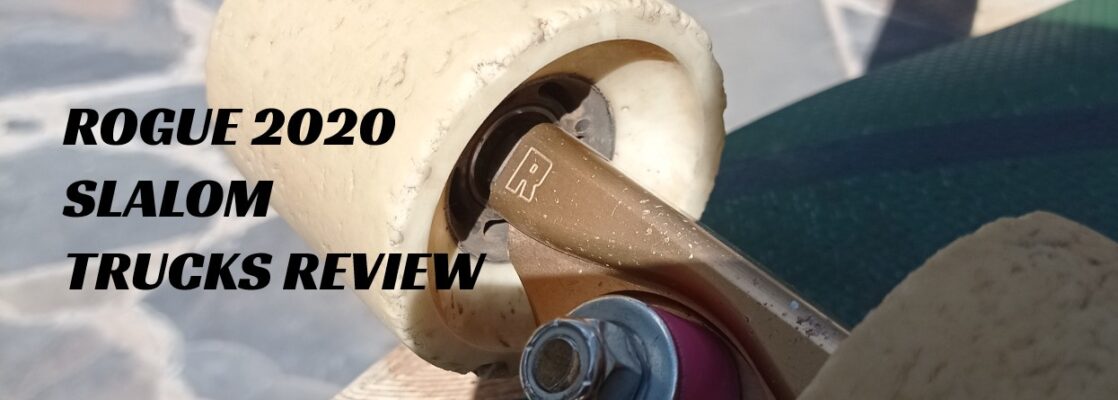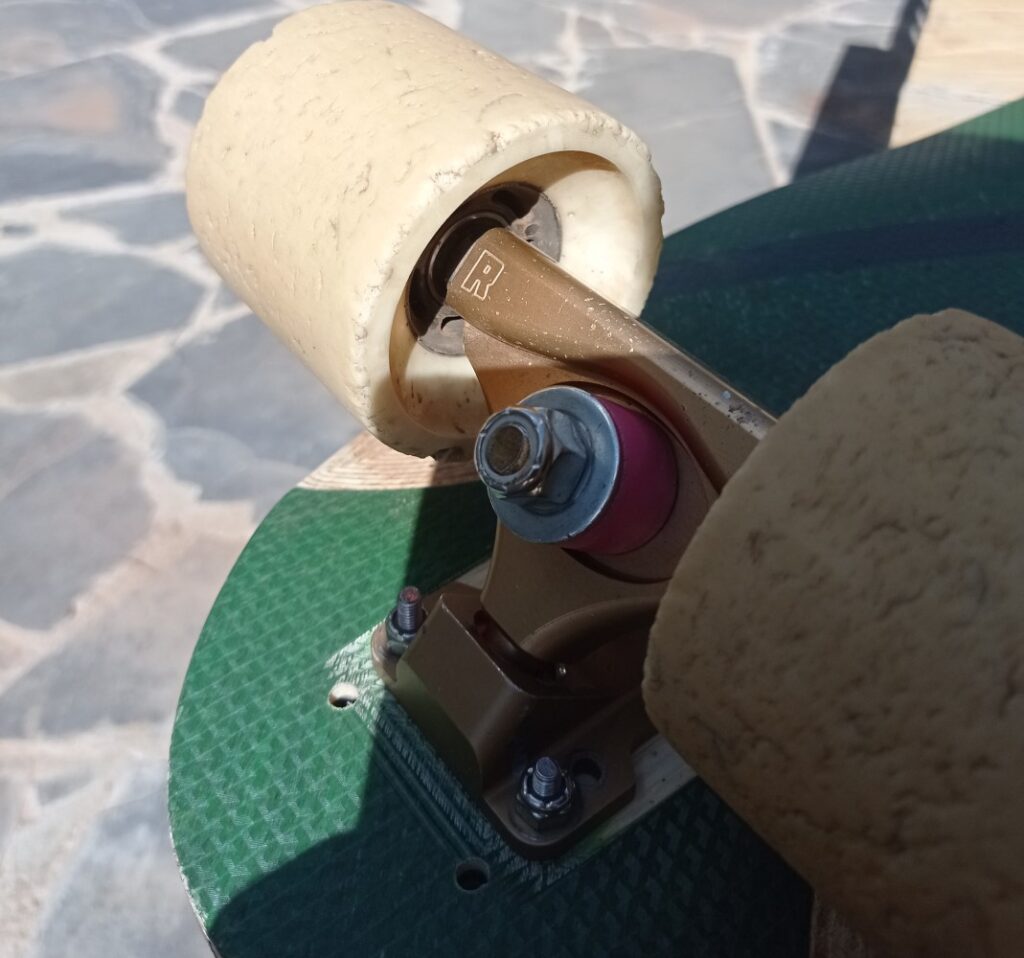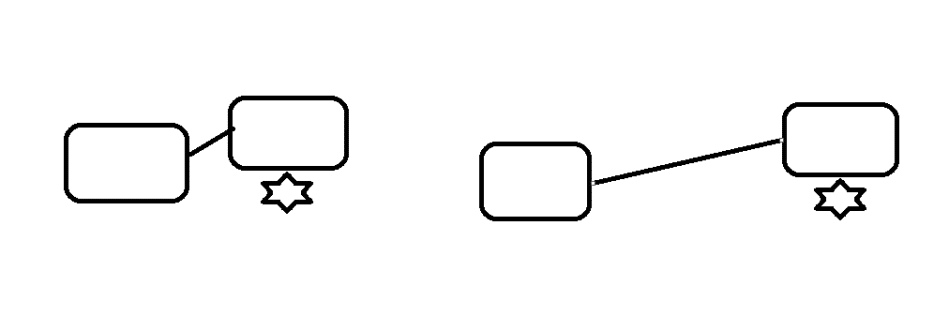There is a lot to talk about when it comes to the Rogue Precision Slalom Trucks, and I talk about it all! Everything from how to ride them best, which upgrades to make, and even how to change up your riding style. Check it out below.
Specifications
- Baseplate Angles: 50/20
- Width: 106-116mm
- Rake: 8mm
- Front Truck
- Bushings: 73/78a Venom HPF bushings
- Washers: Cupped washer RS, no washer BS
- Insert Bushing: 93a Venom HPF
- Pivot: 93a grey Venom pivot tube
- Rear Truck
- Hanger: Trailing axle design w/ axles inline w/ bushing seat.
- Bushings: 95/97a Venom HPF bushings
- Washers: Cupped washer RS, no washer BS
- Insert Bushing: 93a Venom HP
- Pivot: 93a grey Venom pivot tube
- Price: $400
Rogue Precision Slalom Trucks Review
Summary
The Rogue 2020 Slalom trucks are some of the best I’ve ever skated. They allow me to skate fast and on the limit with a lot of confidence.
They’re incredibly stable – which loads of riders showcase by going 70mph all the time on them, but are also maneuverable enough to make it around the tightest of hairpins. You can thank the asymmetrical hangers, the inserts, and the flat split angles for these things.
They certainly have disadvantages – with them not being the quickest reacting trucks but once you adapt to this it stops being an issue. And with the plethora of tunability and options to customize these trucks, you can get a workaround that works for you.
Altogether, I’m seriously impressed with these trucks, and I mostly have positive things to say. They are a well-put-together piece of kit!
What makes them special?
The Rogue 2020 trucks are precision slalom truck designed with downhill skateboarding in mind.
Built off the design of the old Precision Rogues, they feature the same slop-stopping system, but come with hangers that have more rake, an asymmetrical design, and have a huge angle split between the front and rear baseplates.
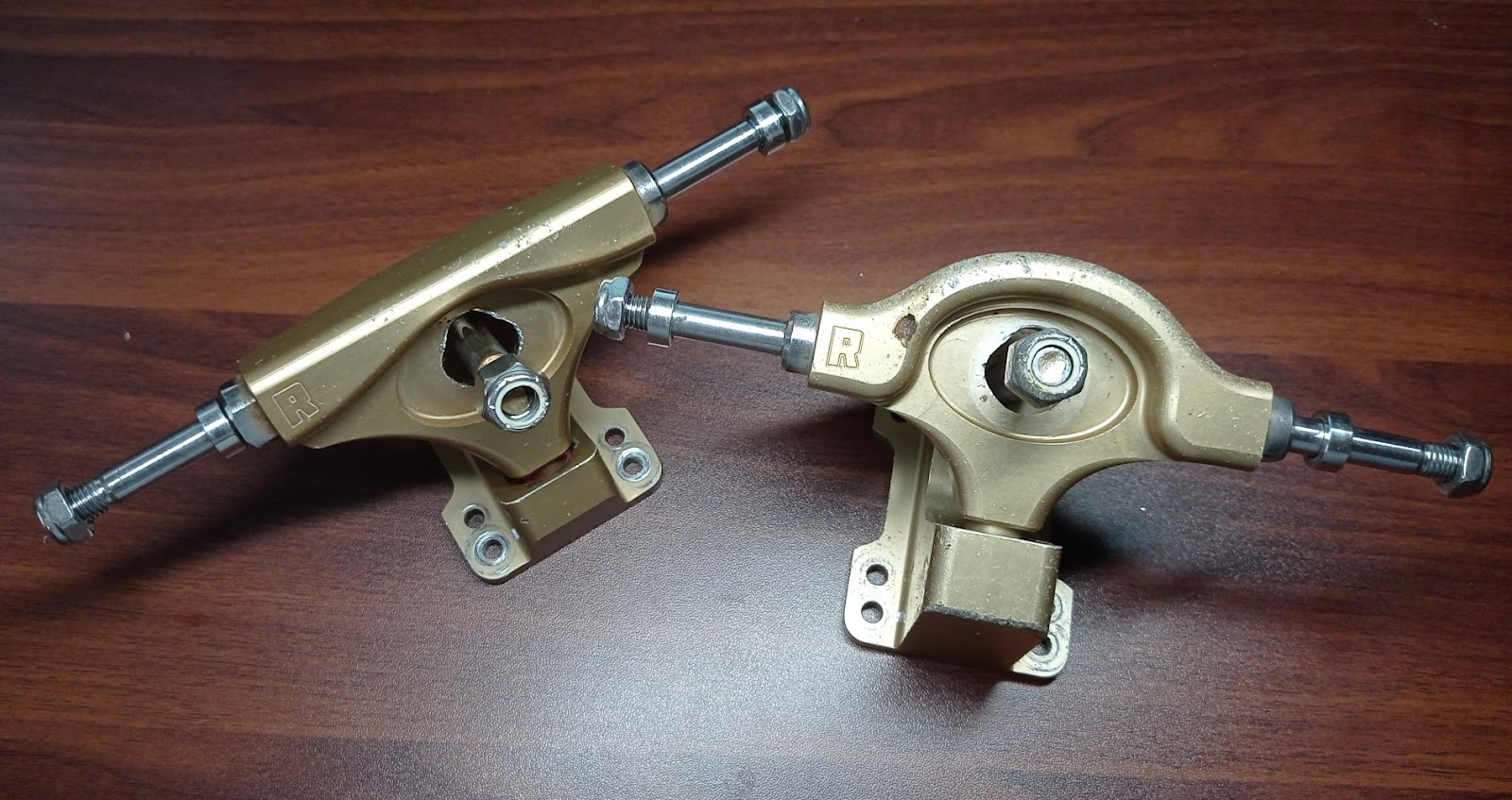
These trucks aim to maximize on maneuverability, grip, whilst still providing a stable and easy to control ride.
And the proof is in the pudding – mf really go 70mph on the regular on these, whilst still being able to make it around the tightest of hairpins.
These are a departure from the “normal” precision trucks that have been in the market for over a decade now, and signal a change of an era; drawing a more defined line between gear for pure hands down downhill, and gear for freeriding.
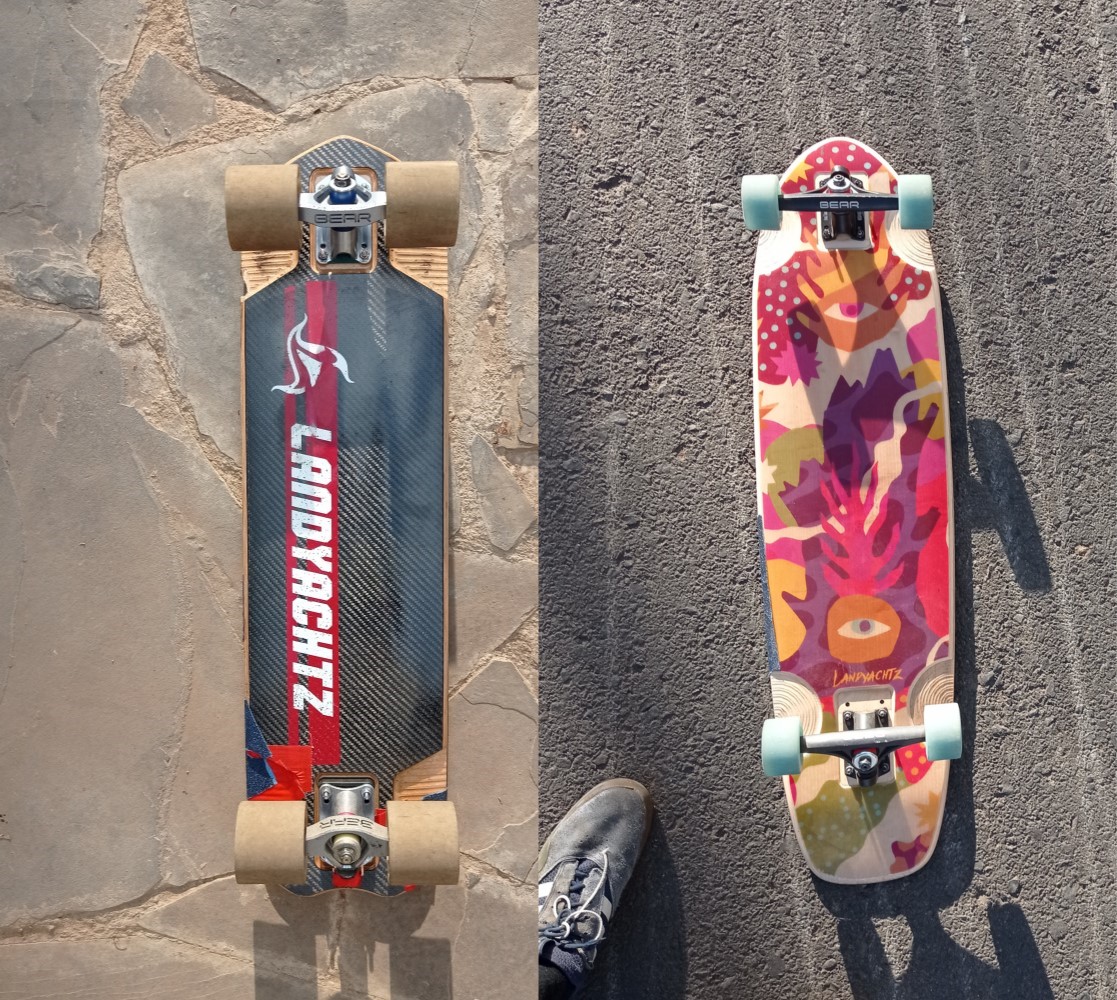
I say they signal a change because I feel like it was Rogue that really made DH slalom trucks more mainstream. There were certainly other downhill slalom trucks before and after Rogue slaloms, but Rogues got people (and other companies) on the hype train.
They’re not “true” slalom trucks
Set up right, you can get these things to wiggle around cones, but they aren’t true slalom trucks; these things have been designed with downhill skateboarding as the main focus. It is more accurate to call them “downhill slalom trucks”.
But they are meant to be ridden on stiff, narrow boards with short wheelbases, just like proper slalom trucks.
Actual Rogue 2020 Slalom review
Are Rogue trucks stable?
These trucks are very stable. They’re inherently stable thanks to the trailing link axle design and low angle baseplate in the back. But another key component in that stability is the insert bushing.
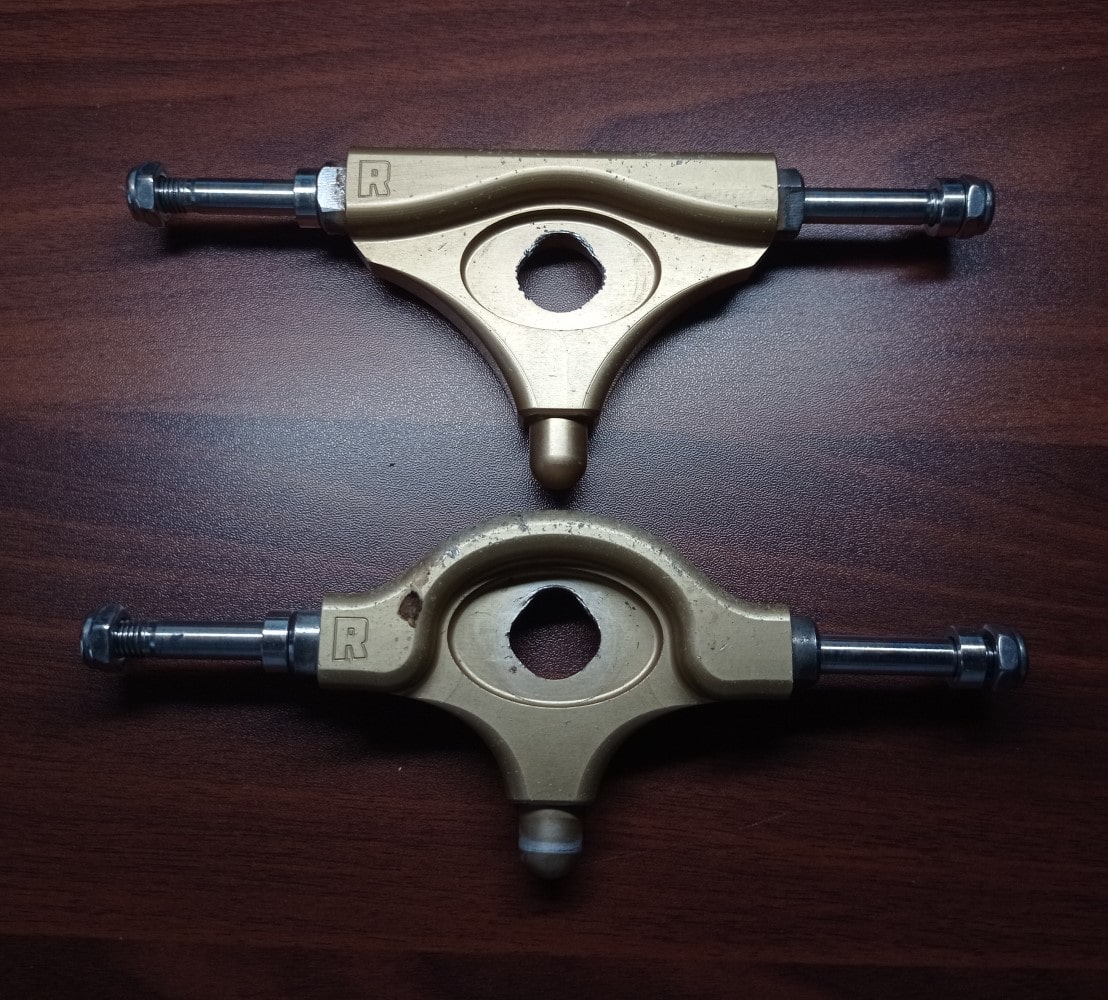
The insert bushing gives you a nice fat center – meaning the trucks don’t want to articulate (turn left or right) without any input from the rider.
With no left or right input from you, they just want to sit and keep going straight.
When riding, this translates to the insert bushing keeping the truck going in a straight line and you don’t have to work much as a rider to keep them stable.
In some ways, it feels like you can sit back, enjoy the ride, and let the trucks do most of the work.
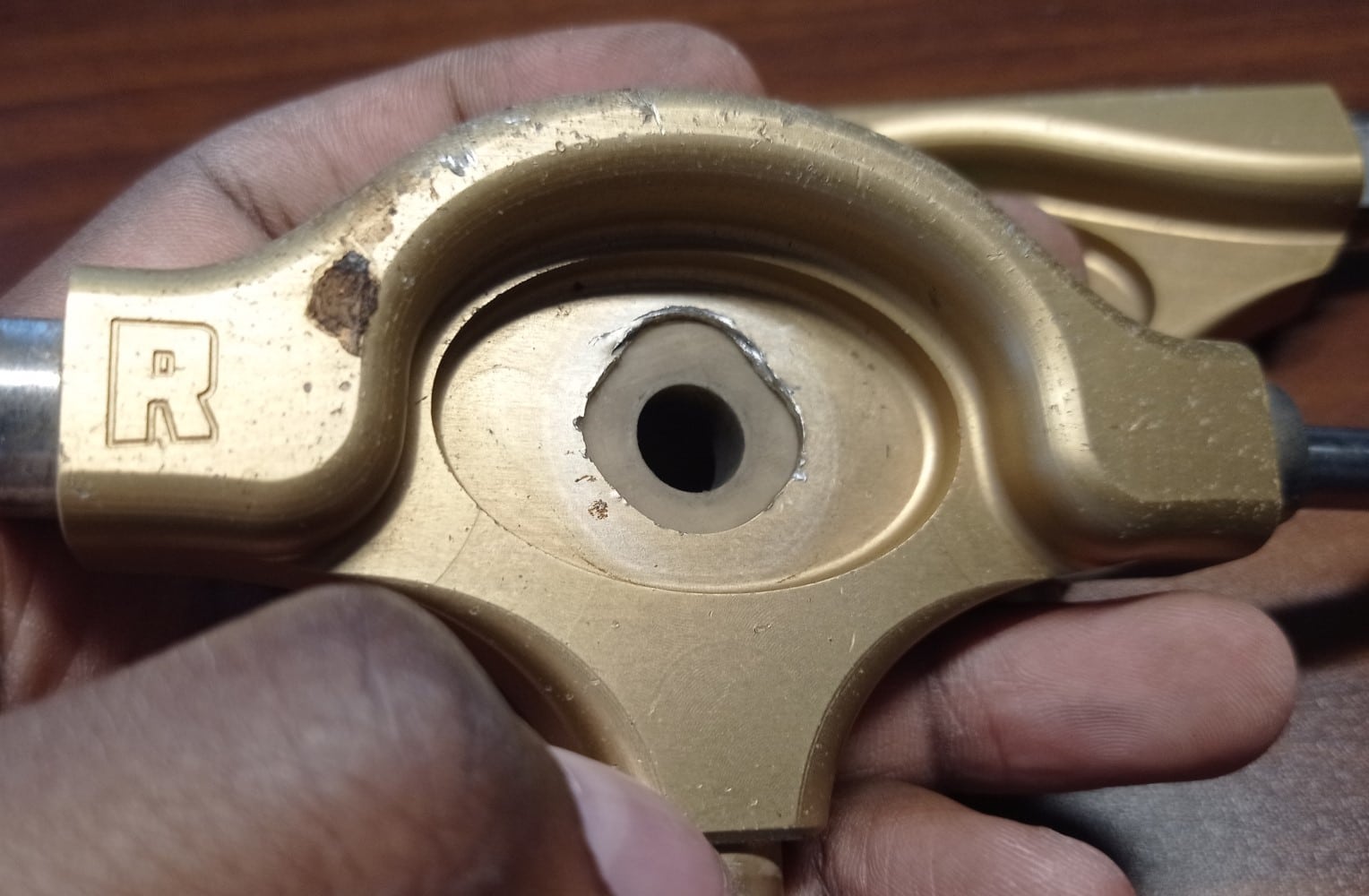
Do they feather out road vibrations and imperfections (rough road performance)?
Brief – how the insert bushing behaves
When you do want the truck to turn/articulate, you need a deliberate input to overcome the resistance of the insert.
When the truck does eventually turn, the insert bushing fights back and wants to return the hanger to the center – where it is not being engaged.
More on this later, but it is important to understand how it works for the following.
(and I’m making it sound like the return to center is so aggressive, but to be clear it’s easy enough to overcome once you give a deliberate input on either side of the trucks, and turning left and right is easy enough).
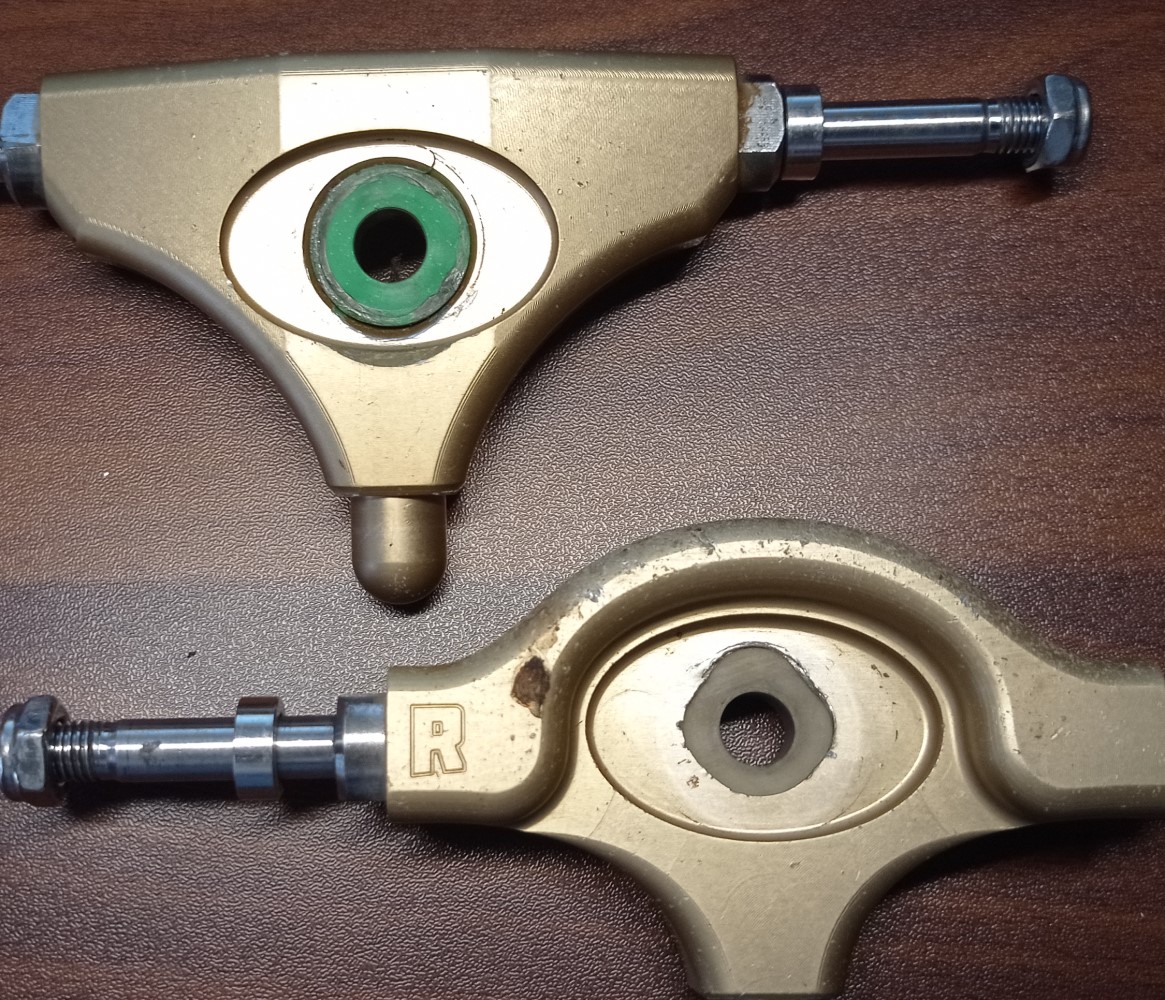
What happens when you ride over a crack/roughness
So when you go over a road imperfection with the Rogue slaloms, (imperfection being a bump in the road, a rough patch, a wave, etc.), one of two things may happen:
- The truck doesn’t really react to it – as you need a deliberate input to make it articulate. You feel the bump but your truck doesn’t react to it.
- The truck briefly reacts to it, but the insert quickly brings the hanger back to the center.
In a normal truck, what would usually happen is the truck will “react” a lot to a road imperfection. This reaction shows up as a twitch, wobble, or a very sudden articulation of the hanger.
Rogues may briefly react to the imperfection and then return to center.
Other trucks don’t have an insert returning their hangers to the center, so they will typically oscillate/react a lot more from road imperfections.
This, as you can imagine, results in a very confidence-inspiring ride on the Rogues.
These trucks feel great over rough roads; they stay stable in the straights and stay planted through the rough corners.
And it’s not to say other trucks aren’t stable or are twitchy, but it’s that Rogues are VERY good at handling those road imperfections.
But, the above said this aggressive return to center of theirs can have its disadvantages.
How do they turn?
Once they deviate from that center you get access to a lot of the turning – almost all at once.
This affects how you ride them – but more on that later on.
But yeah, when I first tried them I got wheelbite because of the sudden turning and immense lean. I ate it sooo bad man. Bro, I was just in my parking lot messing around but bruuuuh. I ate the ground so bad …
Confidence-inspiring turn
When you get the truck leaned over, the insert bushing provides resistance, which helps support and provides feedback to you throughout the lean. (Other trucks have a cupped bushing seat to do this, Rogues have no bushing seat, but the insert bushing, the pivot, and the bushings do the work instead).
Because you get support from the insert, you will feel confident taking sudden turns at speed and staying leaned over.
It also feels like your direct input is matched by the trucks and they do exactly as you tell them. It is quite nice. They only turn the way you want them to, when you want them to.
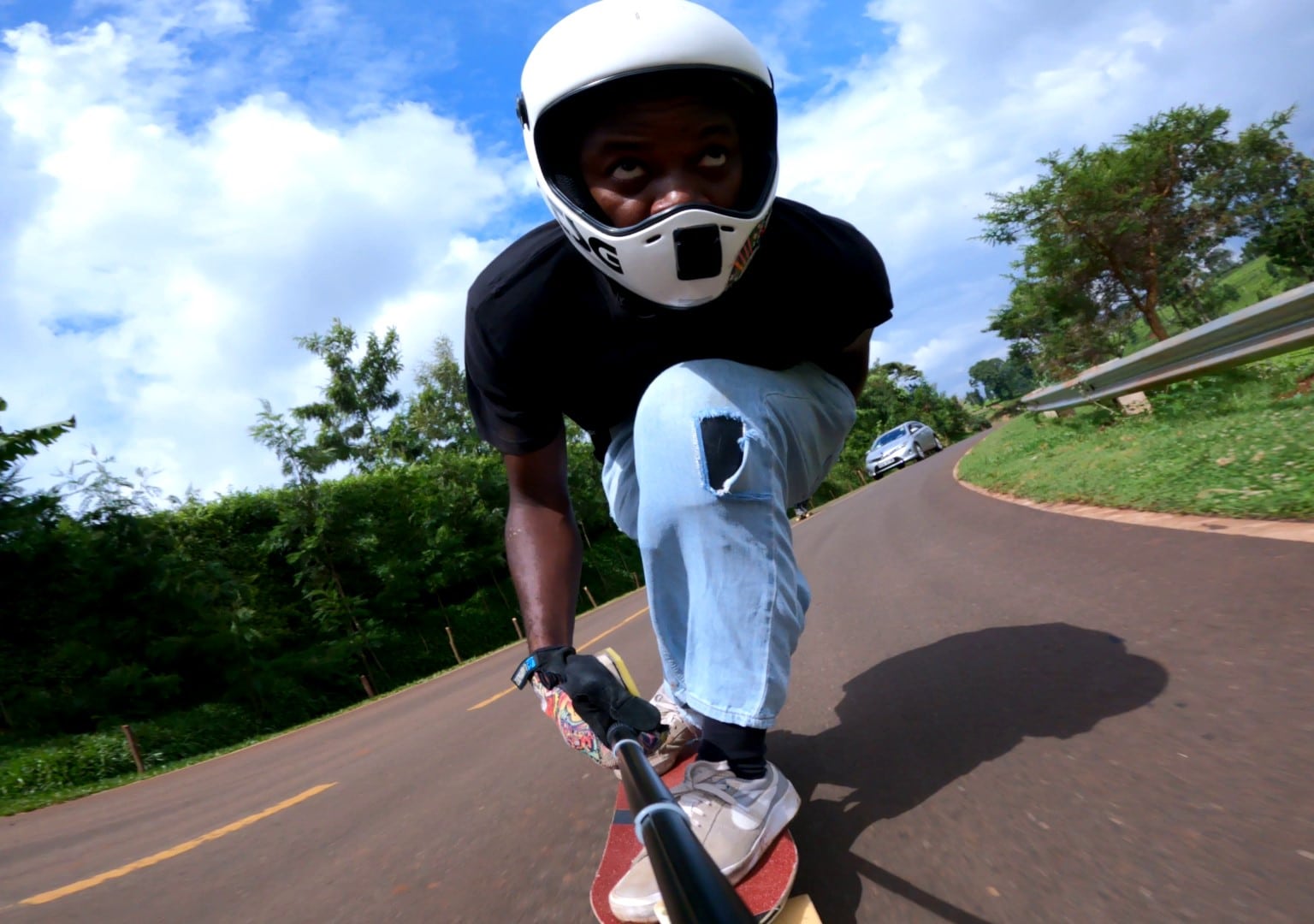
They sometimes feel a bit unreactive
RRogue Precision Slalom Trucks aren’t the most reactive of trucks. Because of how the insert wants to keep the hanger center, you can’t articulate off the center very quickly; it’s hard to get a very rapid dive off the center.
So initially they feel a tiny bit sluggish before turning deeply.
I’m making it sound like a big deal, but it isn’t. It is a very small thing that won’t get in the way of your riding, but you will notice it.
Fortunately, there are a variety of solutions that fix this issue. Namely a softer insert, a spherical insert, a harder pivot tube, or wedging the trucks. More on these things shortly.
But yeah, because of this, Rogues sometimes feel like they suffer at uber tight corners at slow speeds. I’ve always wanted just a bit more reaction from them.
They lean a lot
With no bushing seat, these trucks lean a lot. So much. Seriously, like, wheelbite is so easy to get with them. Of course, when you skate faster it’s not an issue, but at slow speeds …
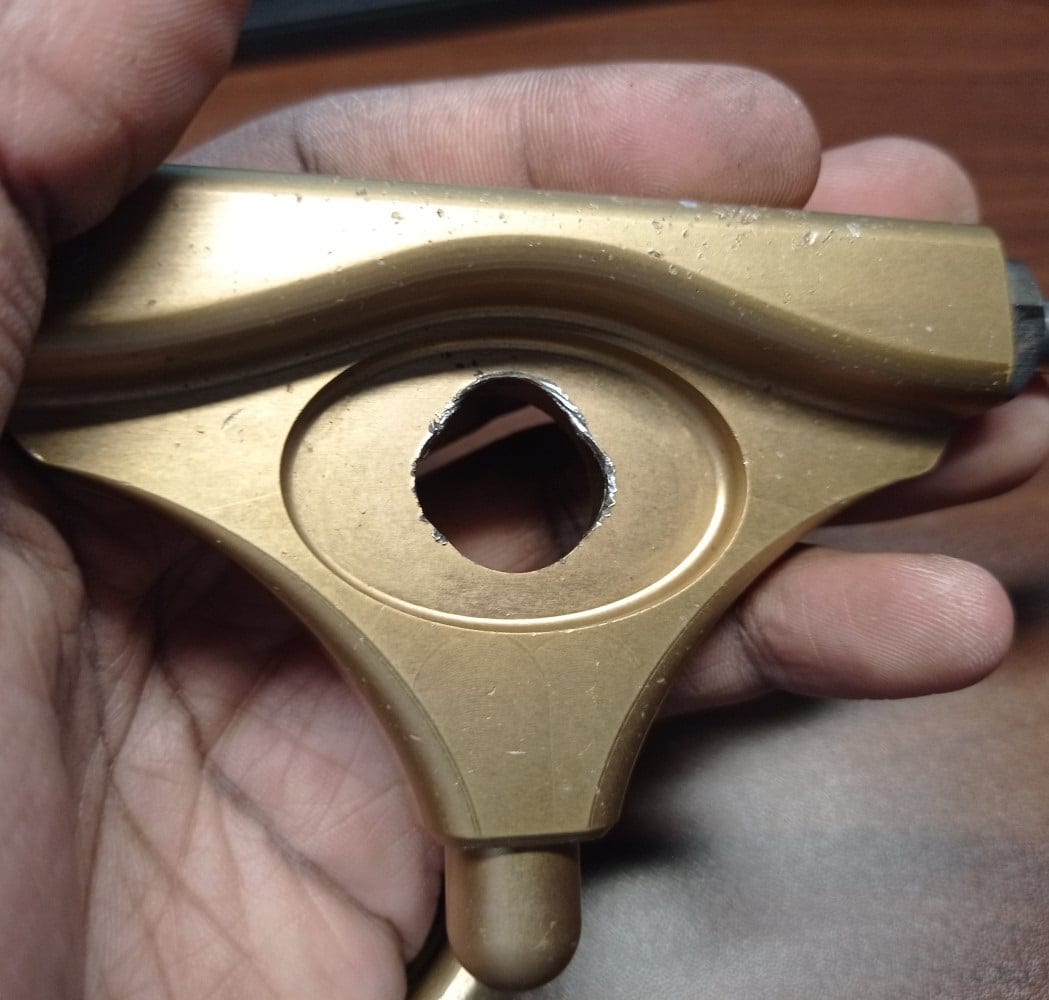
Wheels felt more grippy on these trucks
When sliding these trucks, a lot of wheels felt grippier.
I believe this is because of the insert bushing and how it rebounds and supports you when the truck is leaned over.
More “grip” depending on the insert
When I went with a harder insert, I felt more grip from the wheels; I had to work harder to get them to slide out, and once in the slide the wheels felt like they fought me more. I had to be more aggressive and deliberate with my weight placement to hold them in the slide.
With softer inserts, this was the opposite. The wheels were easier to slide and didn’t feel super grippy.
But yeah for comparison, with 93a inserts, they felt grippier than Smokies. I can’t talk much about other trucks but yeah.
I can’t say if this resulted in the wheels actually slowing me down a lot more with the harder inserts, but the wheels definitely felt more grippy.
What them insert bushings do
We’ve already seen some cases in what an insert bushing does but now let’s dive more into their purpose, how different insert bushings hardness affect performance.
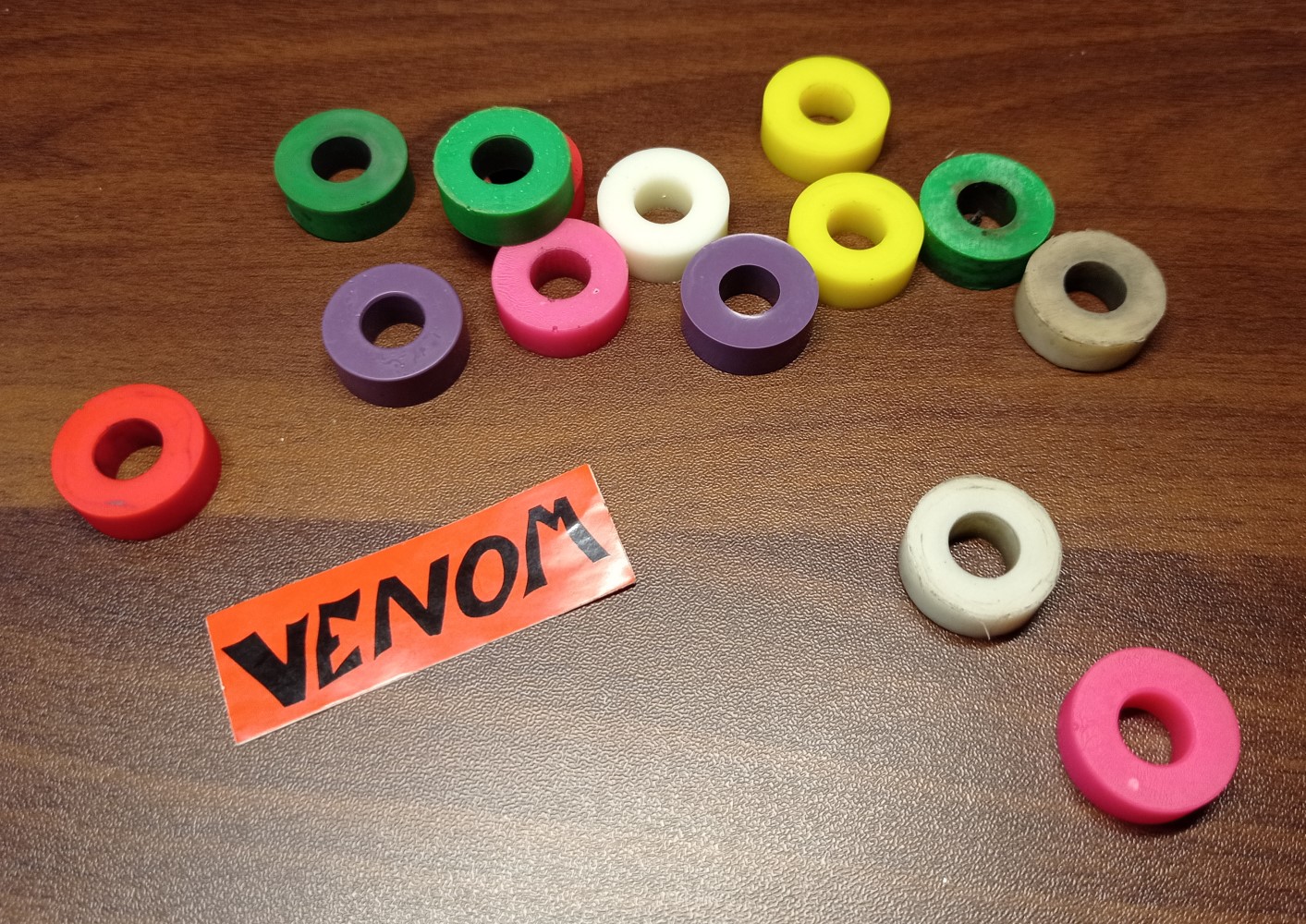
The purpose of the insert bushing
The insert bushing is there to prevent slop. Slop is when the skateboard truck moves in a way that strictly isn’t the axis it’s designed to rotate on … if the hanger moves side to side, up and down, etc.
The insert bushing prevents slop and by extension, also supports the truck through the lean.
Harder vs Softer insert
A harder insert makes the wheels feel grippier and the turning feel less quick. You get more support through the lean.
A softer insert allows the truck to react quicker to your input, but doesn’t provide much support through the lean, and wheels don’t feel as grippy in the slide.
When using softer than 93a inserts, I felt the trucks felt too floppy. I didn’t like it. In the end I felt going for a spherical bearing was a better option.
You can also use a spherical bearing
You can also use a spherical bearing to do the work of the insert bushing.
It doesn’t have rebound and doesn’t support you through the turn, but does allow for a smooth lean on the desired axis.
It also has different performance characteristics from the urethane insert. More on this below.
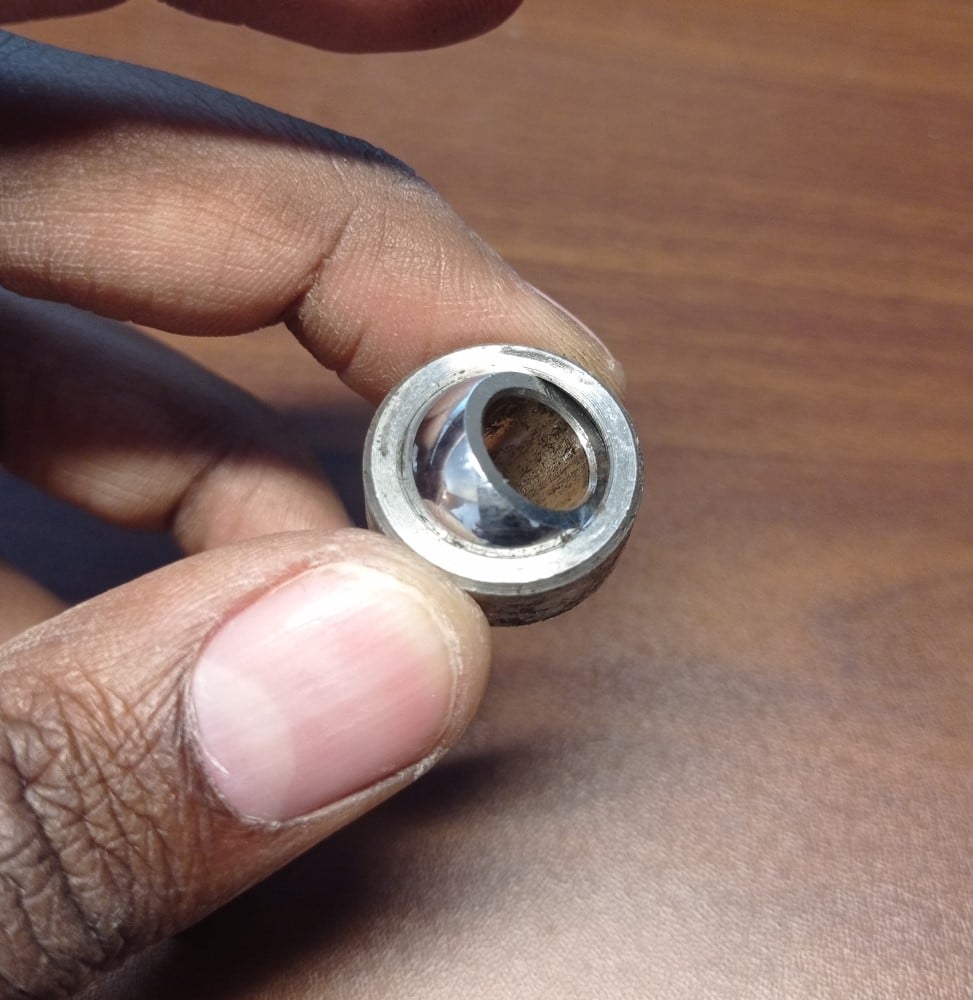
But even with the insert, the truck doesn’t suddenly flop left or right. You still get smooth control and lean when you engage the truck … which is making me rethink how much the insert actually plays a part in supporting you through the lean …
It’s like maybe the insert only affects the slop and the initial part of the lean? I’m not sure about that, which is why this whole paragraph is in italics.
If you have any input on that, feel free to leave a comment.
Which spherical bearing to use …
The part number for the spherical bearing to be used in Rogues is:
- US – 63195K14
- UK/AUS – COM6T.
You can get most bearings through eBay in the UK or through McMaster-Carr in the US, or from SK8kings.
However, Rogues have an odd-sized insert bushing size, so you need to apply some tape around the spherical bearing to get it to fit nicely. You could also machine a small sleeve for it.
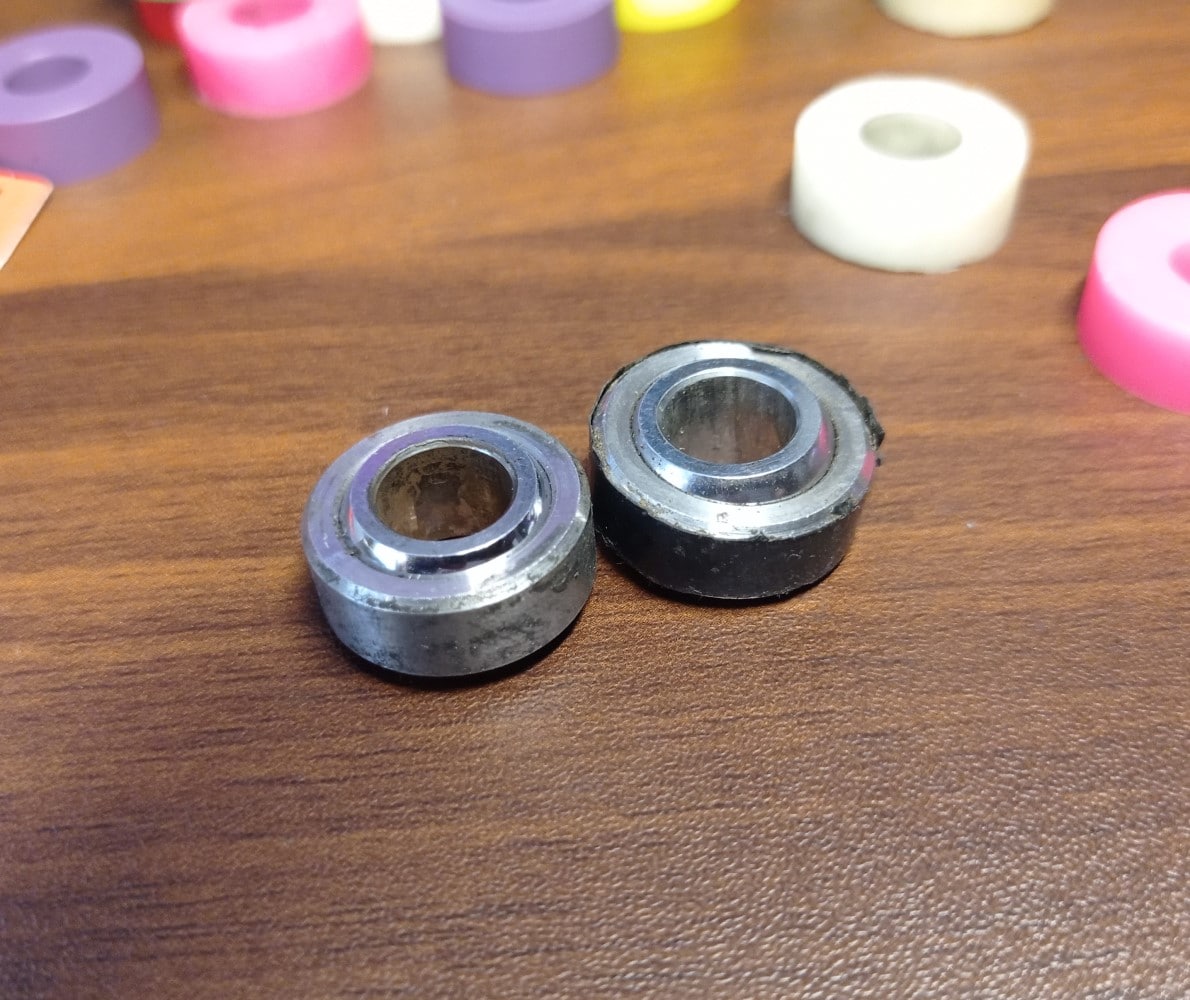
Experimenting with a spherical insert …
Spherical inserts are known for providing a lot of road feedback; which is why a urethane insert is typically preferred for downhill.
Fortunately, you can mix and match them – I was able to use a spherical insert in the front truck and pair it with a 95a urethane insert in the rear truck.
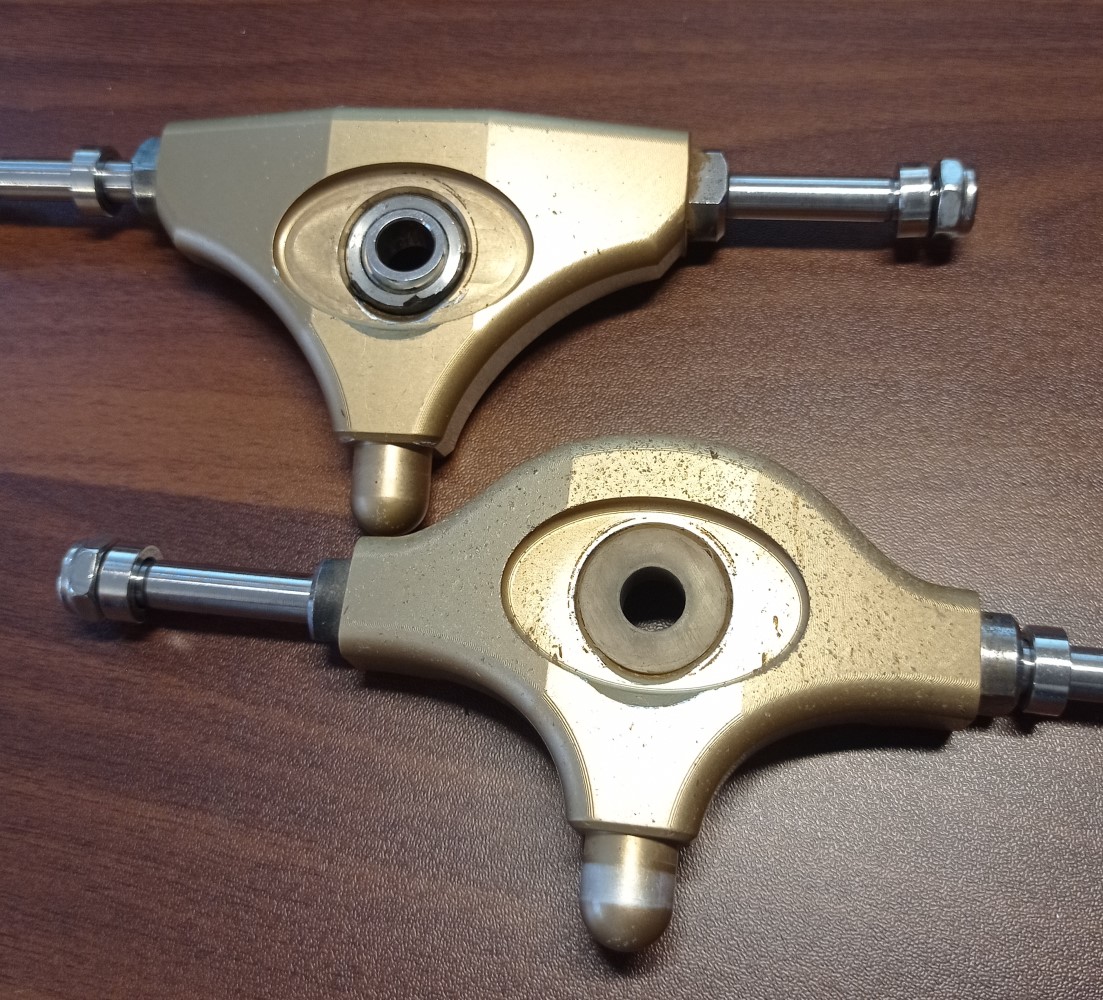
This resulted in a truck that was still stable, still feathered out a lot of road vibration, but just came off that center a lot quicker and allowed the front truck to respond quickly to my input.
They were still well supported through the turn, and whilst the trucks did turn left or right quickly, they never felt “flimsy” or “floppy”. The lean was smooth and controlled. It felt a lot better through the lean, than a 90a insert or softer.
Yes, some of the strong center and (a little) stability was taken away, but it was worth the trade for some more reaction from the trucks. I also felt more of the road, but it wasn’t too bad.
Is a spherical insert worth it?
It’s worth experimenting with.
If you think the Rogue Precision Slalom Trucks can be too sluggish in that initial point of articulation, then the Spherical insert might be the solution for you.
But both insert and bearing have their advantages. It’s not clear which one is outright better. I’d say it’s just different ways of setting up and running these trucks.
How I (mostly) run my Rogue Precision Slalom Trucks
- Baseplate Angles: 50/20
- Front Truck
- Hanger width: 106mm
- Bushings: 73/78a Venom HPF bushings
- Washers: Flat washer RS, no washer BS
- Insert Bushing: 93a Venom HPF or sphericals
- Pivot: 97a pink Venom pivot tube
- Rear Truck
- Hanger width: 116mm
- Bushings: 95/97a Venom HPF bushings
- Washers: Cupped washer RS, no washer BS
- Insert Bushing: 95a Venom HP
- Pivot: 97a pink Venom pivot tube
What widths to use on these trucks?
Let’s look at the widths these trucks have available for use. A lot of people tend to run them 106mm in the front and 116mm in the back.
Having tested both symmetrical and asymmetrical widths, I’ve found that the asymmetrical width (106/116) is the most superior and desirable. You can feel the differences when you’re on the limit.
Symmetrical width
With a symmetrical width (either 106/106 or 116/116), it’s easier to slide the back out, and harder to get the front to turn in – with the same insert bushings front and back.
At the limit, it’s a tiny bit harder to ride it and the back truck just keeps slipping out.
It honestly feels like these trucks weren’t designed to be ridden like this.
If you want to stand-up slide these trucks, this isn’t a bad way to run them. But for max performance, I do not recommend it.
But depending on your setup (wheels and deck), they can also feel just like other symmetrical width trucks when you skate them this way.
106 front, 116 back
With the trucks this way, it’s so much easier to approach the limit, skate hard, and take very aggressive lines without fear of the back suddenly slipping.
However, you have to go for a harder insert in the back truck. For example, you might run 93/95. Without the harder insert, the back truck can feel a bit too floppy and reactive.
But yeah, 106/116mm, allows you to skate hard; it feels like the back truck wants to stay planted and follow the front truck around corners. It doesn’t want to slide out, which is great for skating near the limit.
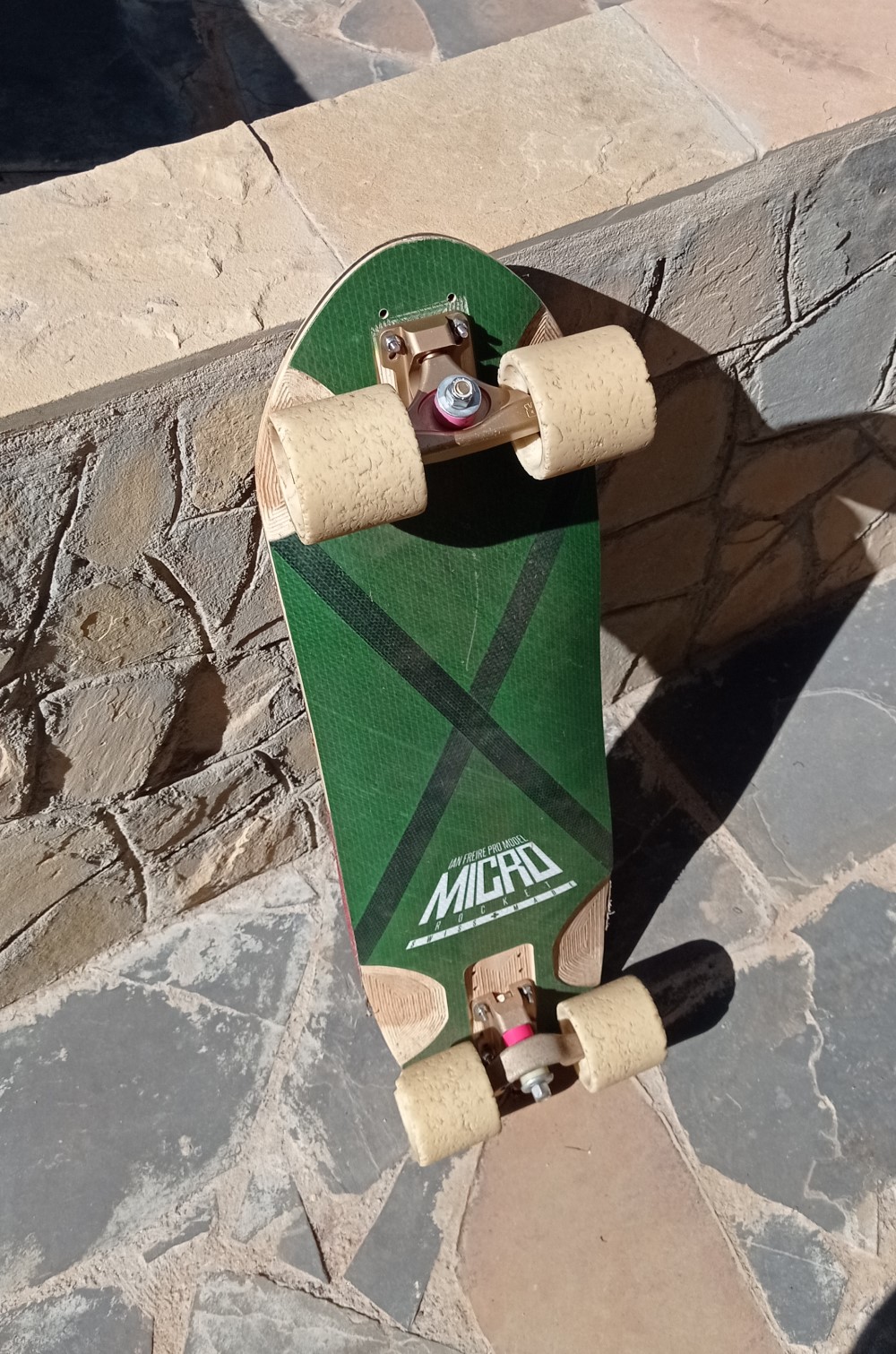
116 front, 106 back
When I tried this, I didn’t get a conclusive answer.
It just felt like the front was a bit harder to turn in and the back reacted to my input a bit more.
IDK, if you mainly skate off your back foot this could work for you? Maybe if you want to make the back wheels work more?
I can’t say I see a clear advantage of 116/106mm, as I do with the other options. But it is an option …
Harder insert back is always superior
No matter how you run the width, a harder insert in the rear always gives you pretty decent performance.
It just felt like it made the back truck want to follow the front truck more, which is most desirable in using them.
Other stuff I tried …
You should switch out the pivots
The only true update I made (I don’t consider the spherical bearing switch a proper update), is using a 97a venom pivot tube instead of the stock 93a ones.
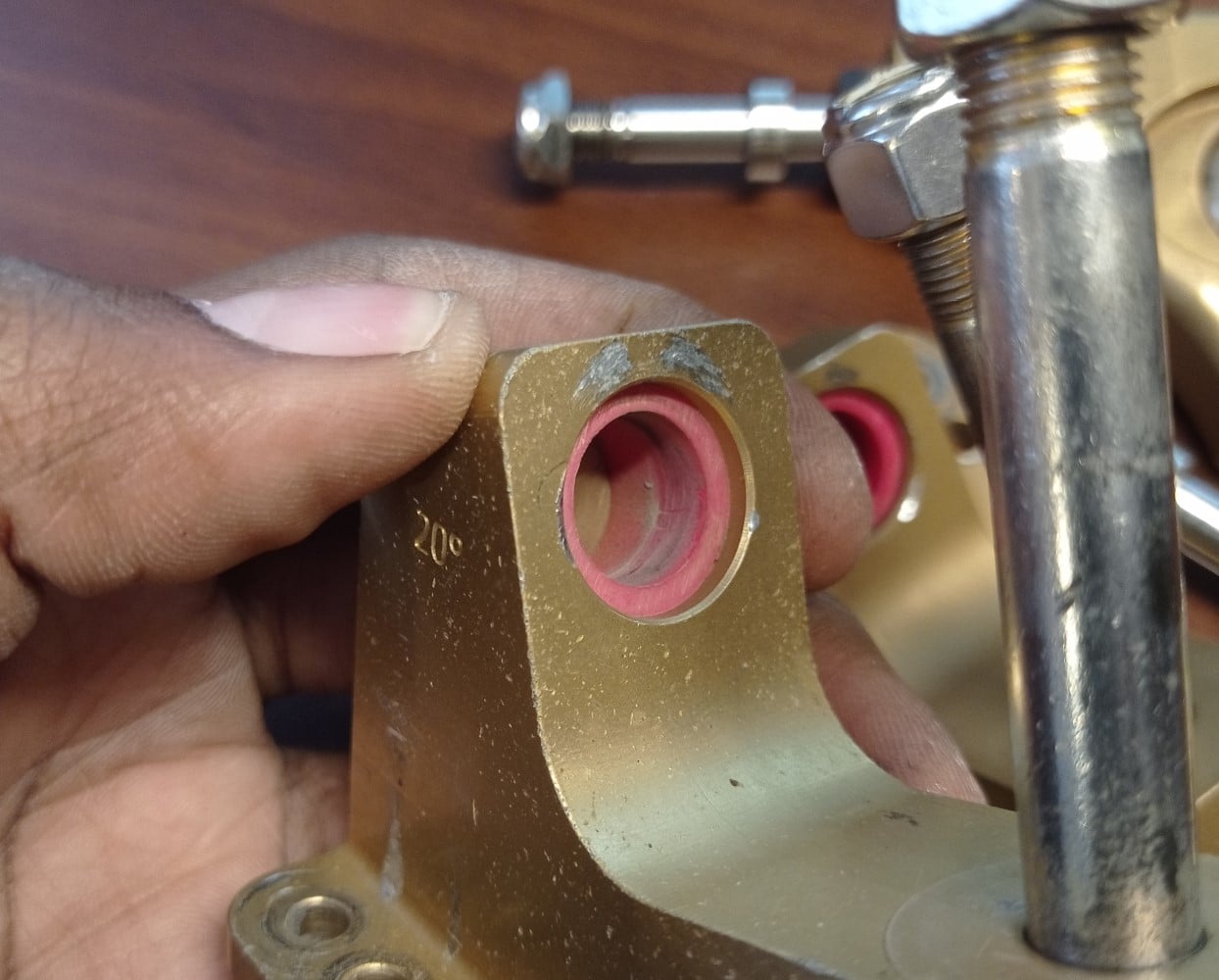
This gave me a more reactive ride – the trucks were quicker to articulate and respond to my input, but still had a relatively smooth/gradual lean. This improved on the “slowness” or rather lack of reactivity I felt from them initially.
It felt amazing with the 97a Venom pivot tube and I wouldn’t run them any other way. Highly recommend trying the 97a pivot.
Why not Riptide pivot?
I also tried the 95a WFB pivot from Riptide (they don’t have pivot tubes so you have to cut the tip-off for the right fit).
I didn’t like them at all.
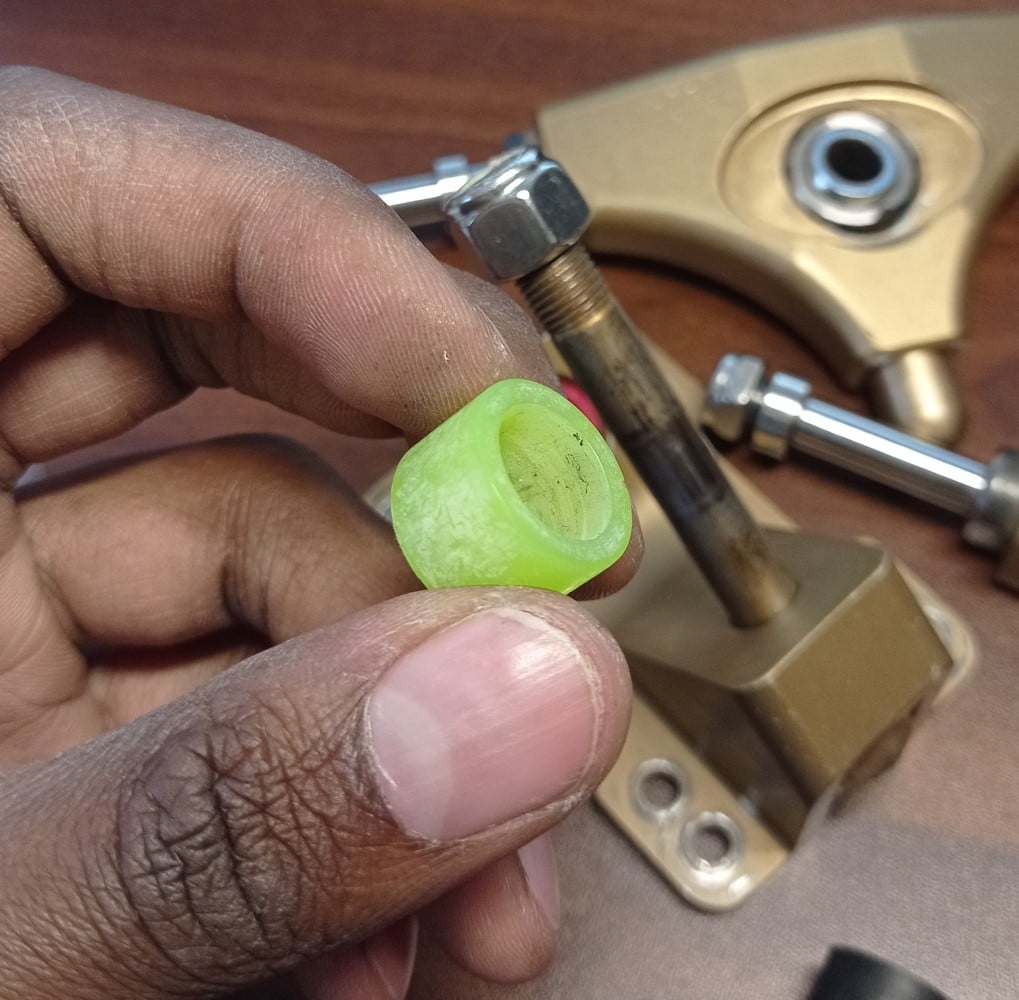
They allowed the truck to respond quicker to my input, but sometimes it felt like it was waaay too quick. The dive was too sudden and I didn’t get the quick, but gradual lean I desired …
As a side note, I think I’m falling out of love with Riptide pivots. I did not enjoy them at all in Savants and didn’t like them fresh in the Smokies, but once some dirt got in there I swear the truck felt better lol …
Wedging to 53/23 is very good?
I’ve had a handful of people tell me that the sweet spot for these trucks is a 3* positive bump in truck angle. Comet sells their Orbiter complete with 3* wedging because of this and Descent skateboards even sell some of their boards with 2.5* wedging up front too, to allow for this.
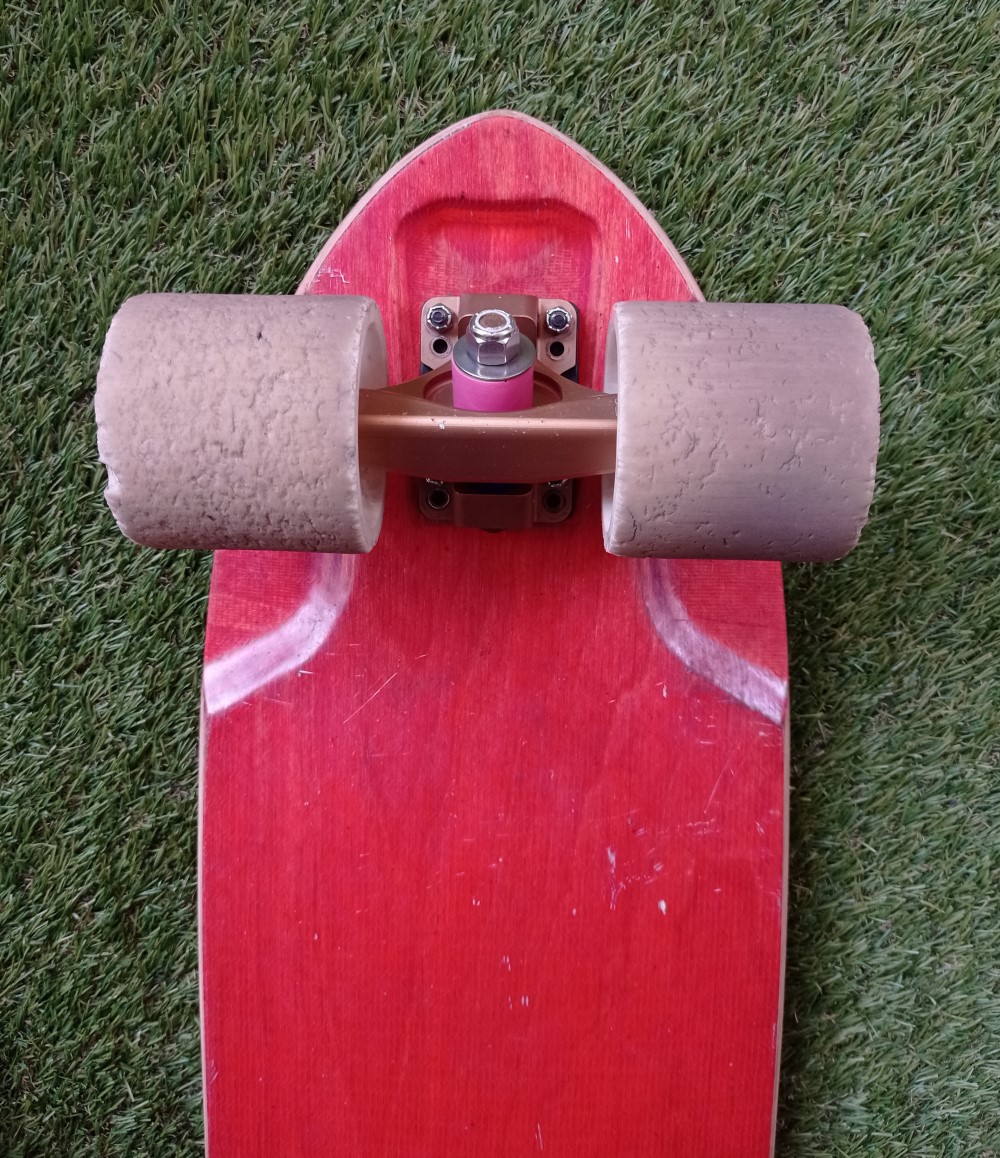
So is it better?
The higher angles took away some of the sluggishness I had found earlier and made the trucks turn and react a lot better to my input.
Sliding them felt a bit weird but within a couple of runs it felt a lot better and I got used to it.
I would say 53/23 is a great way to run these trucks and would overcome some of the shortcomings, without really sacrificing stability. If you find them a bit sluggish, 53/23 will work well for you.
How to best ride Rogue Slalom trucks (some tips)
The below is things I’ve picked up on that have allowed me to skate these trucks as well as I can. I noticed them by looking at how other riders ride them, and also noticing what naturally felt better on these trucks when switching between them and the Bear 2020 Smokies.
I think it’s important to point this out – it may cut down your learning curve significantly. This means more time enjoying them and less time figuring them out.
They’re meant to be ridden fast and aggressively
You gotta push yourself to skate these hard m8. That’s the only way you get decent performance from them. They feel good near the limit. If you’re feathering them, they just feel meh and even underperform in some cases.
Weight placement
You’re mostly gonna be turning with your front foot with these trucks. You need to have your weight up there to get that front truck to turn. You also get the best stability by keeping your weight forward.
I recommend skating with your front toe over the corresponding wheel. You’ll get decent turning toeside this way.
No setup carving for the best performance
I’ve found that setup carving for turns and slides doesn’t produce the best results with these trucks.
**This was less of an issue when I used the spherical bearing but it was still a bit apparent.
When you set up carve, it’s kind of like the truck over articulates and this makes you severely understeer into the corner or slide. Resulting in poor performance.
Do this instead
What instead you should do is set up carve less, sort of go into a straight line, AND THEN turn or turn into the slide.
It’s like, once you overcome the center the truck turns a lot.
By setup carving, you overcome the center quickly, and then the trucks turn too much too suddenly – overcoming the grip of your wheels causing you to understeer.
I also felt the same issue with Ronins. The best performance came from not setup carving, but by sort of loading up the board to slide or turn.
If you do this you will be rewarded with incredibly deep turning, grip, and control. I promise. If you don’t believe me, watch how Rogue riders skate. No setup carve m8.
Footstop position
You want your footstop position to not be too much over the front truck. You want your foot to be about halfway between the bolts of the front truck.
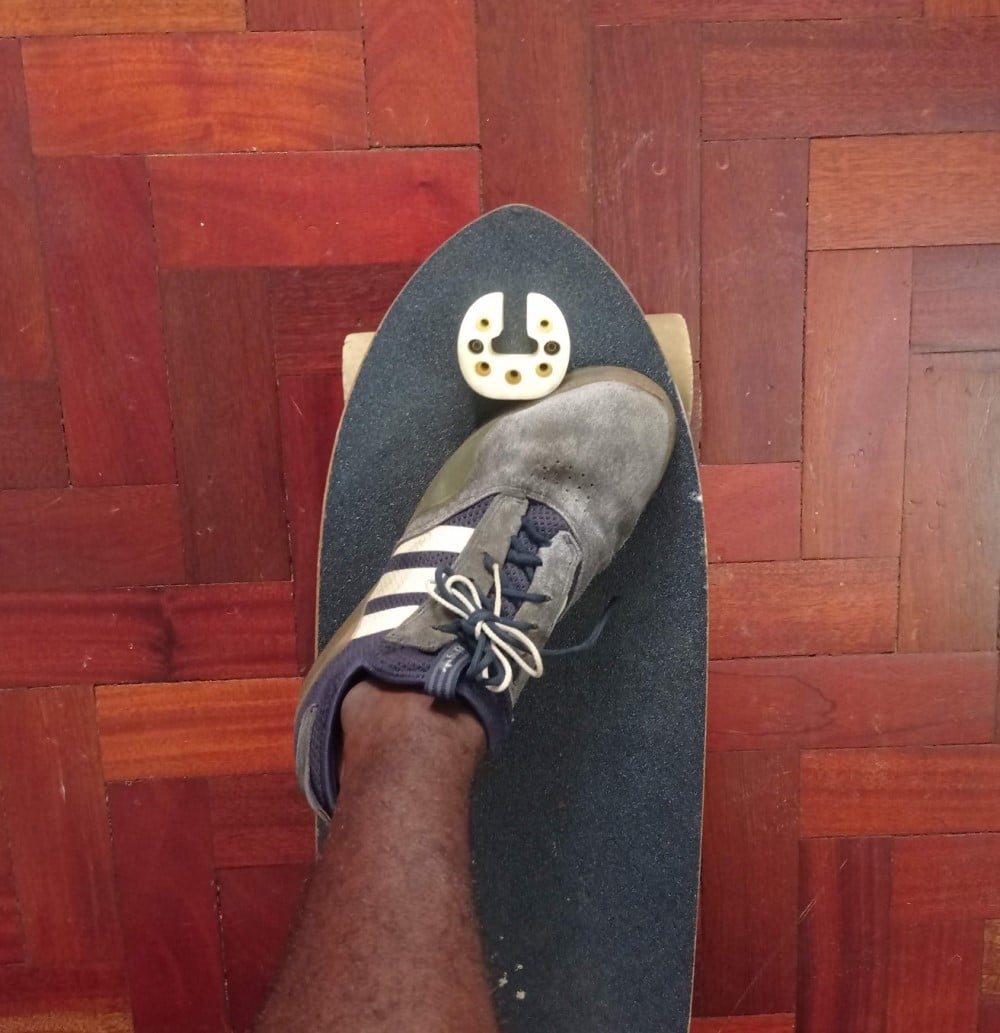
Idk why, but they felt best this way
Sometimes I felt like they needed a riser to work best
These trucks felt like they performed best with a decent amount of leverage. They never felt quite right with flush mounting that was too deep – think about 1/4inch deep.
So with flush mounting, a riser might be the way to go to get the best feel.
Things I didn’t like
Too long kingpin and Axles
Thanks to an ordering error, the kingpins, and axles on these trucks are a bit too long.
The long kingpin is really annoying. You can’t skate some wheels that are too small and they catch on all sorts of things when you’re riding around. Every other second you hear kkkkkkkk and you feel your nut scrape the ground.
The new Rogues shouldn’t have this issue, and if you have the old Rogues, you can always hacksaw off the excess amount of kingpin.
Not always available
I’ve heard that the new Rogues are coming soon. But between the shortages caused by COVID, these being a niche and in high-demand truck, the Rogues aren’t always in stock.
Bump steer
Though they are stable and feather out a lot of the road vibration/imperfections, you get a lot of bump steer.
I don’t think I’m describing it accurately, but sometimes when you skate over a crack, you feel it. The trucks don’t react to it, but you really feel it. It’s not instability and maybe bump steer isn’t the best way to describe it. But you feel it from these trucks more so than other narrow precisions like Smokies or P2s.
Kinda like the image below (thanks @pederhsx for this). But it’s like, instead of flexing, the whole truck goes up … idk ..
Just something to note.
That initial turn-in/sluggishness
As I have lamented above, I disliked how restrictive the initial turn-in was. However, it is a necessary evil. After adapting your style and skating for a while, it’s not much of a problem.
Not enough space between mounting holes and kingpin thing on the baseplate
IDK what the thing that holds the kingpin and the pivot is called, but on these trucks, there isn’t enough space between it and the holes where the bolt goes.
This results in your skate tool scraping the side of this thing, causing unnecessary damage to your truck. This doesn’t happen on most of the other precision trucks I’ve tried.
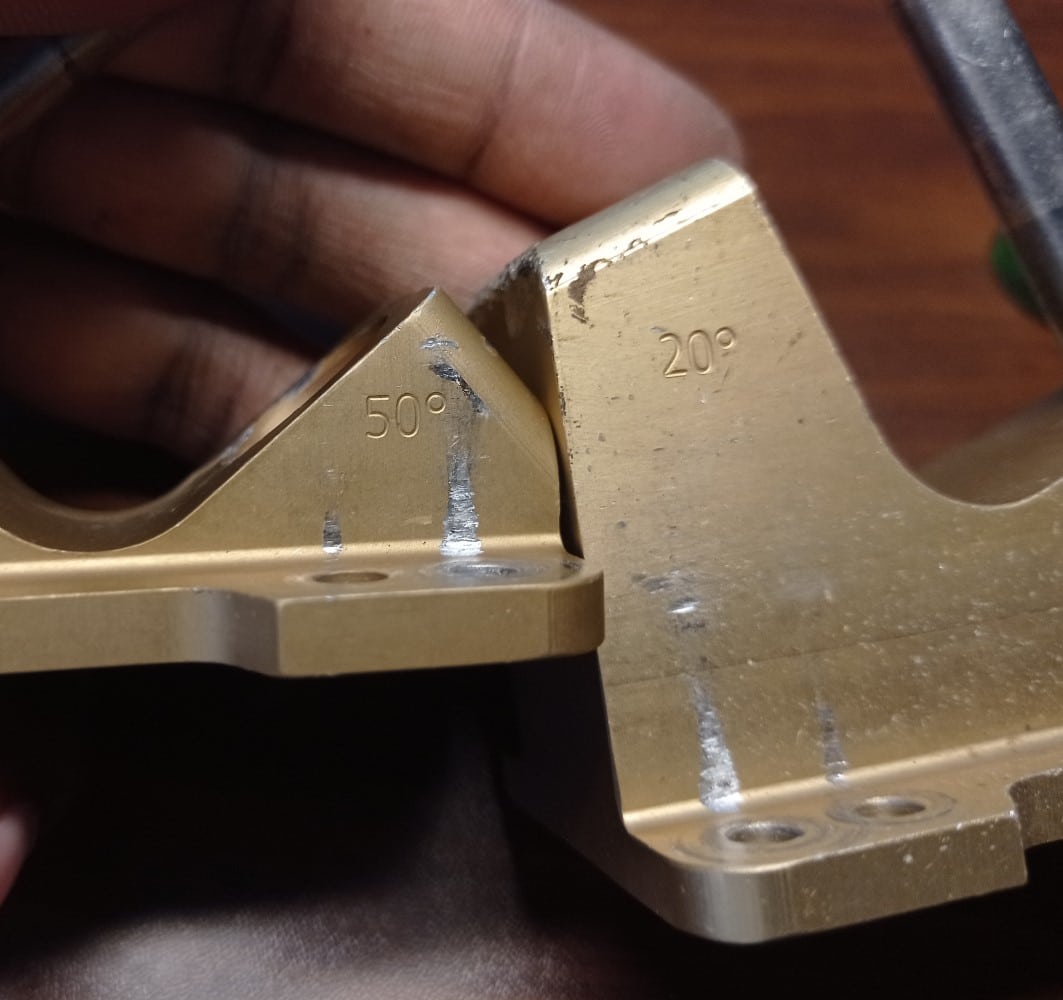
It is annoying when putting on your trucks and scraping this thing time and again. It doesn’t affect performance, but it is annoying. Especially for me as I take my trucks off quite a bit.
What do you guys think? Are the Rogue Precision Slalom Trucks right for you?
This has been one of my favorite reviews to make. There is so much depth to this truck and getting to know how to make the most out of it has been a lot of fun. Stoked to put this together for y’all.
If you’ve had any different experiences, feel free to comment. You can do so if you’d like to add anything too!
Also, you can always join my Patreon to see all the product reviews before they drop publicly. There are always a handful available – I make more and can only post on Youtube weekly.
Big thanks to all my patrons for the support – David, Squirrels Adventures, Mike, Jed, Mowgii, Jan, Josh, Jay, Jay, Bryan, @owencampbell777, @dkwan, Alex, Kasajja, Domnik, Reuben, @pablo.vega.andrade, Vlad, Asa, Helge, DeLacoste, Peder, Josh, Mike, Anthony, @issishreds, Greg, Jackson, Slipa, Louisa, Bill, Steve, John, and Justin. I couldn’t write articles like this without you guys’ support.
